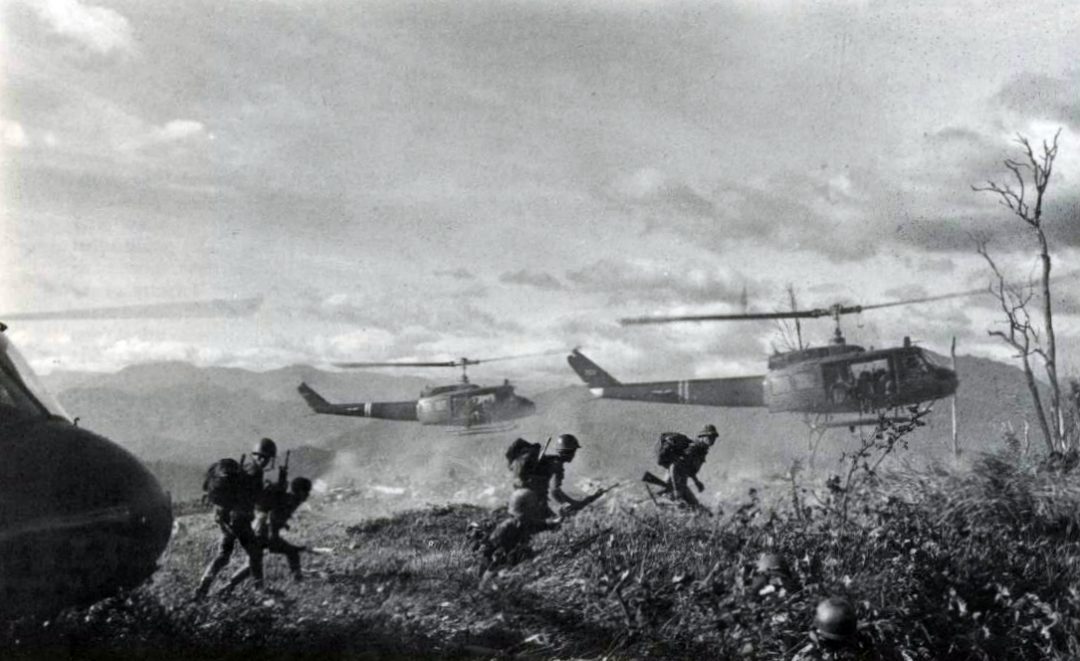This is an image of the Vietnam Soldiers actively fighting in the Vietnam War[1]. The Vietnam War was a historical war that included not only the country of Vietnam split into North and South, but also surrounding countries, mainly the United States and the Soviet Union. The United States Air Force took this image on July 12, 1970, as Vietnam soldiers were airlifted to Northeastern Vietnam, specifically landing at Landing Zone Kala. This image depicts the severity of this war, as in the picture soldiers are running as the helicopters take off after dropping them off at these coordinates. Helicopters were a notable part of this war given how important they were in situations such as this one. Their relevance was stressed, and helicopters became a defining image of the Vietnam War, embodying its constant mobility and complexity. Alongside troop transportation, helicopters were also used for air support in medical evaluation, close air support, resupply, and scouting[2]. Soldiers even went as far as to describe them as lifelines, as much a part of the war experience as the jungle itself.
The Vietnam War was a long, but intense war lasting from November 1, 1955, to April 30, 1975. North Vietnam and South Vietnam held different stances on the way the country should be governed. The Soviet Union supported the North, by pushing for the idea of a system-run government being led by communistic views, and the United States supported the non-communistic, democratic system of government in South Vietnam[3]. The Vietnam War had lasting effects on Vietnam, as well as conflicts between the Soviet Union and the United States due to the different views held on government. As tensions increased from what was already present and had unfolded during the Cold War. As Jeffrey P. Kimball explains in “Russia’s Vietnam War”, the Cold War was a fight between the Soviet Union and the United States over their continued conflict of interest regarding the system of government[4]. This was a worldwide disagreement, that had taken dominance throughout many countries resulting in the taking of sides of many smaller, less involved countries.
Furthermore, during the Vietnam War, massive protests were sparked in the United States. The most major protest was the anti-war movement. In the United States, this movement was deeply connected to the Vietnam War, emerging as one of the most significant and wide-reaching social movements of the 20th century. The movement arose in response to growing public discouragement of the war’s legitimacy fueled mostly by the high American casualty rates and brutal realities of the conflict[5]. Activists criticized the war as unjust and imperialistic, arguing it disproportionately harmed civilians in Vietnam while diverting resources from domestic issues. College campuses became the main locations of protest, marches drawing millions of participants. Events like the Tet Offensive and the release of the Pentagon Papers further intensified public opposition by revealing the government’s misleading narratives about the war’s progress. The movement pressured policymakers, contributed to the decline of public support for the war, and ultimately played a role in the U.S. withdrawal from Vietnam in 1975.
With that, this war was just a Proxy for the United States. They did not have direct involvement; however, they just took the side of South Vietnam and provided them with their troops and war equipment to assist them. When the United States later looked at the numbers they had sent to war and lost, they knew it was time to withdraw because it was no longer worth losing soldiers over. Consequently, Northern Vietnam triumphed in the Vietnam War, because President Nixon, signed and released the Paris Peace Accords. This, according to Thomas T. Lewis, was an agreement for peace, signed on January 27, 1973, that would end the Vietnam War.
To conclude, this piece demonstrates how the relevance of the Vietnam War Era, became a main concern for many countries because of their involvement and the effects it had on those who were not involved. For example, the cost of war, its effects on the environment (with the various types of machinery used), and the political instability that was thrown into play affected the entire world. The picture emphasized the smoke bellowing from the round, and the guns in the soldier’s hands with their determination to get to where they were sought to be positioned next. It demonstrated a sense of rigidity among the soldiers, and the canvas displayed in black and white emphasized this point more. This image strongly portrays the landing zone, as well as tactics necessary for the military with a secure foundation for their leaders to be mobile and have an advantage of the view of their surroundings.
[1] U.S. Air Force (Operation Holly 1970 (Folder 13 of 15), sheet 182), 12 July 1970. Date Accessed: 2 October 2024. https://commons.wikimedia.org/wiki/File:U.S._Army_UH-1H_Hueys_insert_ARVN_troops_at_Kh%C3%A2m_%C4%90%E1%BB%A9c,_Vietnam,_12_July_1970_(79431435).jpg
[2] Lepore, Herbert P. “The Coming of Age: The Role of the Helicopter in the Vietnam War.” Army History, no. 29 (1994): 29–36. http://www.jstor.org/stable/26304086. Date Accessed: 2 December 2024.
[3] Lewis, Thomas Tandy, “Vietnam War.”, Salem Press Encyclopedia, 2022, Research Starters
https://research.ebsco.com/c/dq7v4l/viewer/html/uknv6c22ef Date Accessed: 29 October 2024
[4] Kimball, Jeffrey P. “Russia’s Vietnam War.” Reviews in American History 25, no. 1 (1997): 157-
162. https://dx.doi.org/10.1353/rah.1997.0016. Date Accessed: 29 October 2024
[5] Guttmann, Allen. “Protest against the War in Vietnam.” The Annals of the American Academy of Political and Social Science 382 (1969): 56–63. http://www.jstor.org/stable/1037114. Date Accessed: 2 December 2024.
